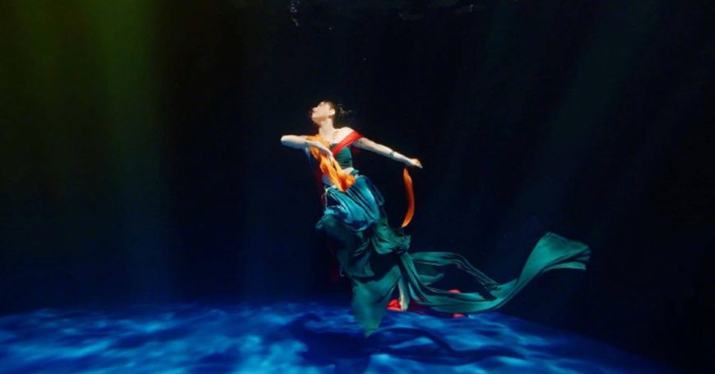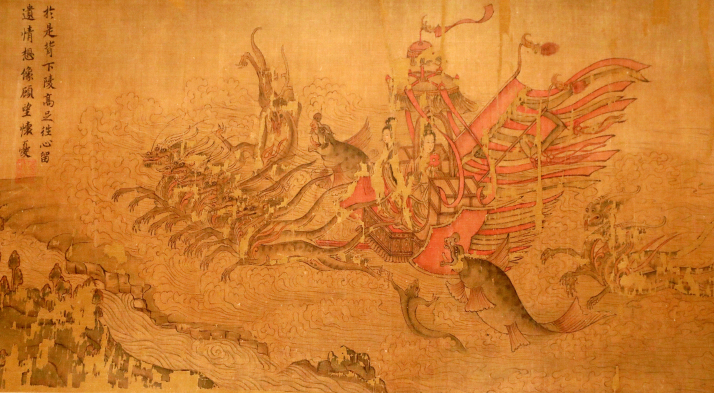| Lifestyle |
| Henan Satellite TV's cultural programs win the hearts of the nation, especially those of the younger ones | |
|
|
 A video screen shot of the underwater dance Pray (FILE)
Her body soars lightly like a startled swan, Gracefully, like a dragon in flight, In splendor brighter than the autumn chrysanthemum, In bloom more flourishing than the pine in spring; Dim as the moon mantled in filmy clouds, Restless as snow whirled by the driving wind. This is how Cao Zhi (192-232), a premium poet from the Three Kingdoms period (220-280), depicted and eulogized the Goddess of the Luohe River in his classic poem Ode to the Goddess of the Luohe River. The Luohe River flows across Henan Province in central China, where the Chinese civilization in the Yellow River basin appeared over 5,000 years ago. There has been no lack of classical Chinese dances adapted from this ancient classic, but an underwater performance really is a rare sight. Thanks to a special gala aired on Henan Satellite Television (Henan TV) to celebrate this year's Dragon Boat Festival, audiences were able to appreciate "the Goddess of the Luohe River" dancing underwater in a video. According to statistics from Henan TV, within two days of its debut, the video, entitled Pray, was played more than 100 million times, while the hashtag A Wondrous Journey on the Dragon Boat Festival, named after the gala, was searched for 3.5 billion times on Weibo, China's answer to Twitter. Some exclaimed that this performer could not have been human, but must have been the Goddess of the Luohe River herself, as "no actual human would be able to move so beautifully and gracefully underwater." Foreign Ministry Spokeswoman Hua Chunying commended the dance on her personal Twitter account, calling it "unbelievably beautiful!" Deep-rooted in Chinese culture This particular gala was in honor of the Dragon Boat Festival, which is a traditional Chinese festival on the fifth day of the fifth month on the lunar calendar. This is a festival to pray for good harvest as well as a time to remember Qu Yuan (around 340-278 B.C.), a prominent poet as well as a patriotic government minister living in the Kingdom of Chu during the Warring States Period (475-221 B.C.). Legend has it that he drowned himself in a river on that day after his patriotic political dreams had been shattered. The gala opening sets the scene, and the mood, during a grand sacrificial ceremony in the Tang Dynasty (618-907) taking place on a pier, praying for accommodating weather conditions and good harvests. For this purpose, the gala required a dance attributed to a river goddess. Qu Yuan's writings also mention this Goddess of the Luohe River, said Chen Jia, chief director of the gala. However, as described in Querying the Sky, the Goddess of the Luohe River is draped in very glamorous and elegant robes, which will surely restrict the dancer's movements and ruin the particular type of lightness and agility required on the part of the performer. "Later, it struck us that the Feitian, aka the flying Apsara, from the frescoes of the Thousand Buddha Grottoes in Dunhuang, Gansu Province, who wear light scarfs, can perfectly solve this problem. In this way, the character's dressing is actually a combination of Feitian imagery and the Goddess of the Luohe River as shown in ancient paintings," said Chen. The Goddess of the Luohe River is believed to be the most beautiful and charming goddess in the original Chinese myths. The ancient Chinese believed that there must have been an utterly beautiful and graceful goddess protecting the lush banks running along the river. Although just a common arm of the Yellow River, the river enjoys no less cultural importance than the mother river, particularly because of the many poems and verses devoted to this attractive goddess throughout history. The Pray dance, according to Chen, expresses the people's wishes for peace and prosperity befalling upon all those residing in the nation as well as favorable weather conditions leading up to a profitable harvest. Meanwhile, the decorations covering the dancer are not randomly selected, either. For example, the five-color gauzy scarfs strapped around the dancer's arms have been used for thousands of years as a way to ward off the evil spirits as part of Dragon Boat Festival culture.  The famous painting Ode to the Goddess of the Luohe River by Gu Kaizhi (around 348-409) (FILE)
The gala also touched on other customs of the festival in all seven programs bearing traditional cultural backgrounds, such as using mugworts to treat all types of ailments, wearing perfume sachets to drive away insects, and eating glutinous rice dumplings called zongzi. This is not the first time Henan TV has wowed audiences with its ingenious programs. The network first turned heads with the classical Chinese dance called Tang Gong Ye Yan (Night Banquet in Tang Dynasty Palace) airing on the eve of this year's Spring Festival in February. Within a week of its release, the video was streamed around 50 million times on Weibo and related short videos received over 200 million views on Douyin alone. The inspiration behind the creation of this dance stemmed from eight musician figurines and five dancer figurines dating back all the way to the Sui Dynasty (581-618), unearthed in Anyang, Henan, in 1959 and now housed in the Henan Museum, according to Chen Lin, a choreographer with Zhengzhou Song and Dance Theater in Henan. Tang Gong Ye Yan tells the tale of 14 young musicians' rather eventful experiences whilst making their way toward the royal banquet and finally putting on a grand performance inside the palace on one night about 1,300 years ago. These plump and lovable girls wear crescent-shaped makeup and costumes resembling Tang Dynasty three-colored pottery. A particularly striking feature of this dance is that it breaks the stereotyped atmosphere of Chinese classical dance and offers a sense of amusement, close to that in real life, which appears both jubilant yet graceful at the time of the Spring Festival. The dance soon stirred up a wave of passion among Chinese netizens for the Tang Dynasty beauties. Some drew cartoon images of these girls, some created social media stickers and memes in their honor and some even took to imitating their makeup. Boosted by modern technology While the popularity of these programs should be firstly credited to China's rich classical and traditional culture, modern technologies have also played an indispensable role in pulling off the full-fledged feat. Pray naturally projects an ethereal panorama, with the entire background looking like a colorful Chinese ink painting. To a large extent, this effect comes courtesy of the interaction between water, light and shadow underwater. Shooting dances underwater is by no means easy, and what the audience finally gets to see is a classical piece that combines traditional Chinese dance with advanced modern filmmaking and digital technologies. Tang Gong Ye Yan relies even more heavily on modern digital technologies such as 3D and augmented reality to combine virtual scenes with a real-life stage. The background on the stage keeps changing, displaying famous ancient paintings very familiar to the Chinese like Preparing Newly-Woven Silk, Court Ladies Adorning Their Hair With Flowers and The Vast Land. At the same time, cultural relics and national treasures unearthed in Henan naturally flow into the setting via 3D technology. As a result, what the viewers get to see, is a group of young ladies walking, dressing up, doing their makeup and performing in different places, including inside the palace. To a large extent, it is modern technology that amplifies the beauty of a traditional dance and the magnificence of these antique-styled settings. In this way, China's ancient culture is getting its second wind and taking off on the shoulders of modern technology. Cultural revival As for why Henan TV's galas have managed to play a trump card in an era of rich recreational programs based on various cultures, Pray dancer He Haohao might be able to offer a clue. "The popularity of my dance stems from the public's affection for the style of this kind of performance and particularly for classical Chinese culture," she said. The dancer, born in 1990, spent 26 hours underwater shooting the two-minute actual dance video. She said proudly, "It's my honor to be able to present to the public the essence of our Chinese culture." Conventional views hold that those born in the 1990s and after will naturally prefer modern and imported cultures to ancient, or traditional, Chinese culture. Reality might prove a bit different. Nowadays, a wave of traditional culture resurgence is mustering steam and strength among the younger generations, both online and offline. Chinese Poetry Competition, which was aired on the state broadcasting network CCTV during the Spring Festival in the past six years, has been winning a growing number of participants and viewers, most of them students and young university graduates. Short videos on huafu, the traditional Chinese costumes, are spreading on various social media platforms at home and abroad. The Central Committee of the Communist Youth League of China designated the third day of the third month on the lunar calendar as Chinese National Costume Day in 2018, in a bid to support and encourage this traditional dress among the broader public. A lot of young people are learning about ancient Chinese etiquette at their own initiative, and often exchange their views and experiences on etiquette or classical literary or customs online. Explaining why the gala has stirred up all this hype among the young, Luo Liyuan from Hunan Normal University said, "The younger generation today grows up in a stable and comfortable social environment. They have a good academic atmosphere to dig into ancient culture and have access to various classical literary masterpieces, so it's not hard for them to capture the essence of traditional Chinese culture. Gradually, this culture begins to take root in their hearts. Their demand for classical culture keeps rising." "The Chinese have their own aesthetic standards and perspectives. These programs perfectly fulfill the audience's cultural demand by rekindling the nation's memory and passion for its classical traditional culture," said Lu Zhenzhen, an associate professor at the School of Humanities at Guangzhou University. (Print Edition Title: Reviving Cultural Memories) Copyedited by Elsbeth van Paridon Comments to panxiaoqiao@bjreview.com |
|
||||||||||||||||||||||||||||
|